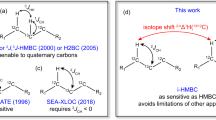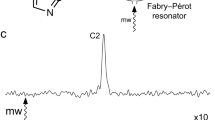Abstract
A nuclear magnetic resonance (NMR) experiment is described for the direct detection of N–H⋯N hydrogen bonds (H-bonds) in 15N isotope-labeled biomolecules. This quantitative HNN-COSY (correlation spectroscopy) experiment detects and quantifies electron-mediated scalar couplings across the H-bond (H-bond scalar couplings), which connect magnetically active 15N nuclei of the H-bond donor and acceptor. Detectable H-bonds comprise the imino H-bonds in canonical Watson–Crick base pairs, many H-bonds in unusual nucleic acid base pairs and H-bonds between protein backbone or side-chain N–H donor and N acceptor moieties. Unlike other NMR observables, which provide only indirect evidence of the presence of H-bonds, the H-bond scalar couplings identify all partners of the H-bond, the donor, the donor proton and the acceptor in a single experiment. The size of the scalar couplings can be related to H-bond geometries and as a time average to H-bond dynamics. The time required to detect the H-bonds is typically less than 1 d at millimolar concentrations for samples of molecular weight ≤≈25 kDa. A 15N/13C-labeled potato spindle tuber viroid T1 RNA domain is used as an example to illustrate this procedure.
This is a preview of subscription content, access via your institution
Access options
Subscribe to this journal
Receive 12 print issues and online access
$259.00 per year
only $21.58 per issue
Buy this article
- Purchase on Springer Link
- Instant access to full article PDF
Prices may be subject to local taxes which are calculated during checkout



Similar content being viewed by others
References
Jeffrey, G.A. & Saenger, W. Hydrogen Bonding in Biological Structures (Springer, New York, 1991).
Shu, F., Ramakrishnan, V. & Schoenborn, B.P. Enhanced visibility of hydrogen atoms by neutron crystallography on fully deuterated myoglobin. Proc. Natl. Acad. Sci. USA 97, 3872–3877 (2000).
Addlagatta, A., Krzywda, S., Czapinska, H., Otlewski, J. & Jaskolski, M. Ultrahigh-resolution structure of a BPTI mutant. Acta Crystallogr. D 57, 649–663 (2001).
Jelsch, C. et al. Accurate protein crystallography at ultra-high resolution: valence electron distribution in crambin. Proc. Natl. Acad. Sci. USA 97, 3171–3176 (2000).
Gerwert, K. Molecular reaction mechanisms of proteins monitored by time-resolved FTIR-spectroscopy. Biol Chem 380, 931–935 (1999).
Becker, E.D. Hydrogen bonding. in Encyclopedia of Nuclear Magnetic Resonance, Vol. 4 (eds. Grant, D.M. & Harris, R.K.) 2409–2415 (John Wiley, New York, 1996).
Dingley, A.J. & Grzesiek, S. Direct observation of hydrogen bonds in nucleic acid base pairs by internucleotide 2JNN couplings. J. Am. Chem. Soc. 120, 8293–8297 (1998).
Pervushin, K. et al. NMR scalar couplings across Watson–Crick base pair hydrogen bonds in DNA observed by transverse relaxation-optimized spectroscopy. Proc. Natl. Acad. Sci. USA 95, 14147–14151 (1998).
Cordier, F. & Grzesiek, S. Direct observation of hydrogen bonds in proteins by inter-residue 3hJNC′ scalar couplings. J. Am. Chem. Soc. 121, 1601–1602 (1999).
Cornilescu, G., Hu, J.-S. & Bax, A. Identification of the hydrogen bonding network in a protein by scalar couplings. J. Am. Chem. Soc. 121, 2949–2950 (1999).
Shenderovich, I.G. et al. Nuclear magnetic resonance of hydrogen bonded clusters between F- and (HF)n: experiment and theory. Ber. Bunsen-Ges. Phys. Chem. 102, 422–428 (1998).
Golubev, N.S., Shenderovich, I.G., Smirnov, S.N., Denisov, G.S. & Limbach, H.-H. Nuclear scalar spin–spin coupling reveals novel properties of low-barrier hydrogen bonds in a polar environment. Chem. Eur. J. 5, 492–497 (1999).
Blake, P.R. et al. Quantitative measurement of small through-hydrogen-bond and 'through-space' 1H-113Cd and 1H-199Hg J couplings in metal-substituted rubredoxin from Pyrococcus furiosus. J. Biomol. NMR 2, 527–533 (1992).
Crabtree, R.H., Siegbahn, P.E.M., Eisenstein, O., Rheingold, A.L. & Koetzle, T.F. A new intermolecular interaction: unconventional hydrogen bonds with element-hydride bonds as proton acceptor. Acc. Chem. Res. 29, 348–354 (1996).
Cordier, F., Nisius, L., Dingley, A.J. & Grzesiek, S. Direct detection of N−H⋯O=C hydrogen bonds in biomolecules by NMR spectroscopy. Nat. Protoc. 3, 235–241.
Dingley, A.J., Cordier, F. & Grzesiek, S. An introduction to hydrogen bond scalar couplings. Concepts Magn. Reson. 13, 103–127 (2001).
Grzesiek, S., Cordier, F. & Dingley, A.J. Scalar couplings across hydrogen bonds. Methods Enzymol. 338, 111–133 (2001).
Grzesiek, S., Cordier, F. & Dingley, A.J. Hydrogen bond scalar couplings—a new tool in biomolecular NMR. in Biological Magnetic Resonance, Vol. 20 (eds. Krishna, N.R. & Berliner, L.J.) 255–283 (Kluwer Academic/Plenum, New York, 2003).
Grzesiek, S., Cordier, F., Jaravine, V.A. & Barfield, M. Insights into biomolecular hydrogen bonds from hydrogen bond scalar couplings. Prog. Nucl. Magn. Reson. Spectrosc. 45, 275–300 (2004).
Barfield, M. Structural dependencies of inter-residue scalar coupling 3hJNC, and donor H-1 chemical shifts in the hydrogen bonding regions of proteins. J. Am. Chem. Soc. 124, 4158–4168 (2002).
Cornilescu, G. et al. Correlation between 3hJNC′ and hydrogen bond length in proteins. J. Am. Chem. Soc. 121, 6275–6279 (1999).
Majumdar, A., Kettani, A. & Skripkin, E. Observation and measurement of internucleotide 2JNN coupling constants between 15N nuclei with widely separated chemical shifts. J. Biomol. NMR 14, 67–70 (1999).
Dingley, A.J., Masse, J.E., Feigon, J. & Grzesiek, S. Characterization of the hydrogen bond network in guanosine quartets by internucleotide 3hJNC′ and 2hJNN scalar couplings. J. Biomol. NMR 16, 279–289 (2000).
Hennig, M. & Geierstanger, B.H. Direct detection of a histidine–histidine side-chain hydrogen bond important for folding of apomyoglobin. J. Am. Chem. Soc. 121, 5123–5126 (1999).
Majumdar, A. & Patel, D.J. Identifying hydrogen bond alignments in multistranded DNA architectures by NMR. Acc. Chem. Res. 35, 1–11 (2002).
Al-Hashimi, H.M., Gorin, A., Majumdar, A., Gosser, Y. & Patel, D.J. Towards structural genomics of RNA: rapid NMR resonance assignment and simultaneous RNA tertiary structure determination using residual dipolar couplings. J. Mol. Biol. 318, 637–649 (2002).
Kojima, C., Ono, A. & Kainosho, M. Studies of physicochemical properties of N−H⋯N hydrogen bonds in DNA, using selective 15N-labeling and direct 15N 1D NMR. J. Biomol. NMR 18, 269–277 (2000).
Bytchenkoff, D., Chiarparin, E., Früh, D., Rüdisser, S. & Bodenhausen, G. Temperature dependence of internucleotide nitrogen–nitrogen scalar couplings in RNA. Magn. Reson. Chem. 40, 377–379 (2002).
Dingley, A.J., Peterson, R.D., Grzesiek, S. & Feigon, J. Characterization of the cation and temperature dependence of DNA quadruplex hydrogen bond properties using high-resolution NMR. J. Am. Chem. Soc. 127, 14466–72 (2005).
Dingley, A.J., Steger, G., Esters, B., Riesner, D. & Grzesiek, S. Structural characterization of the 69-nucleotide potato spindle tuber viroid left-terminal domain by NMR and thermodynamic analysis. J. Mol. Biol. 334, 751–767 (2003).
Delaglio, F. et al. NMRPipe—a multidimensional spectral processing system based on UNIX pipes. J. Biomol. NMR 6, 277–293 (1995).
Barfield, M., Dingley, A.J., Feigon, J. & Grzesiek, S. A DFT study of the inter-residue dependencies of scalar J- coupling and magnetic shielding in the hydrogen-bonding regions of a DNA triplex. J. Am. Chem. Soc. 123, 4014–4022 (2001).
Schwalbe, H., Schmidt, P. & Griesinger, C. Coupling constants determined by ECOSY. in Encyclopedia of Nuclear Magnetic Resonance, Vol. 3 (eds. Grant, D.M. & Harris, R.K.) 1473–1489 (John Wiley, New York, 1996).
Batey, R.T., Inada, M., Kujawinski, E., Puglisi, J.D. & Williamson, J.R. Preparation of isotopically labeled ribonucleotides for multidimensional NMR spectroscopy of RNA. Nucleic Acids Res. 20, 4515–4523 (1992).
Batey, R.T., Battiste, J.L. & Williamson, J.R. Preparation of isotopically enriched RNAs for heteronuclear NMR. Methods Enzymol. 261, 300–322 (1995).
Nikonowicz, E.P. et al. Preparation of 13C and 15N labelled RNAs for heteronuclear multi-dimensional NMR studies. Nucleic Acids Res. 20, 4507–4513 (1992).
Louis, J.M., Martin, R.G., Clore, G.M. & Gronenborn, A.M. Preparation of uniformly isotope-labeled DNA oligonucleotides for NMR spectroscopy. J. Biol. Chem. 273, 2374–2378 (1998).
Rene, B., Masliah, G., Zargarian, L., Mauffret, O. & Fermandjian, S. General method of preparation of uniformly 13C, 15N-labeled DNA fragments for NMR analysis of DNA structures. J. Biomol. NMR 36, 137–146 (2006).
Messerle, B.A., Wider, G., Otting, G., Weber, C. & Wuthrich, K. Solvent suppression using a spin lock in 2D and 3D NMR-spectroscopy with H2O solutions. J. Magn. Reson. 85, 608–613 (1989).
Sklenar, V. & Bax, A. Spin-echo water suppression for the generation of pure-phase two-dimensional NMR-spectra. J. Magn. Reson. 74, 469–479 (1987).
Zhu, G., Torchia, D. & Bax, A. Discrete Fourier transformation of NMR signals. The relationship between sampling delay time and spectral baseline. J. Magn. Reson. A 105, 219–222 (1993).
Bax, A., Ikura, M., Kay, L.E. & Zhu, G. Removal of F1 baseline distortion and optimization of folding in multidimensional NMR spectra. J. Magn. Reson. 91, 174–178 (1991).
Hu, J., Facelli, J., Alderman, D., Pugmire, R. & Grant, D. 15N chemical shift tensors in nucleic acid bases. J. Am. Chem. Soc. 120, 9863–9869 (1998).
Majumdar, A., Kettani, A., Skripkin, E. & Patel, D.J. Pulse sequences for detection of NH2⋯N hydrogen bonds in sheared G·A mismatches via remote, non-exchangeable protons. J. Biomol. NMR 19, 103–113 (2001).
Majumdar, A., Kettani, A., Skripkin, E. & Patel, D.J. Observation of internucleotide N−H⋯N hydrogen bonds in the absence of directly detectable protons. J. Biomol. NMR 15, 207–211 (1999).
Hennig, M. & Williamson, J.R. Detection of N−H⋯N hydrogen bonding in RNA via scalar couplings in the absence of observable imino proton resonances. Nucleic Acids Res. 28, 1585–1593 (2000).
Luy, B. & Marino, J.P. Direct evidence for Watson–Crick base pairs in a dynamic region of RNA structure. J. Am. Chem. Soc. 122, 8095–8096 (2000).
Dingley, A.J. et al. Internucleotide scalar couplings across hydrogen bonds in Watson–Crick and Hoogsteen base pairs of a DNA triplex. J. Am. Chem. Soc. 121, 6019–6027 (1999).
Acknowledgements
We gratefully acknowledge our collaborators Professor Barfield, Professor Feigon and Dr. Bax for their continued support and enthusiasm. This work was supported by SNF Grant 31-109712 (S.G.) and by a stipend of the Boehringer Ingelheim Fonds (L.N.).
Author information
Authors and Affiliations
Corresponding author
Supplementary information
Supplementary Note 1
Bruker two-dimensional HNN-COSY pulse sequence code (DOC 74 kb)
Supplementary Note 2
Conversion and NMRPipe processing script for 2D HNN-COSY data recorded on a Bruker NMR spectrometer (DOC 29 kb)
Rights and permissions
About this article
Cite this article
Dingley, A., Nisius, L., Cordier, F. et al. Direct detection of N−H⋯N hydrogen bonds in biomolecules by NMR spectroscopy. Nat Protoc 3, 242–248 (2008). https://doi.org/10.1038/nprot.2007.497
Published:
Issue Date:
DOI: https://doi.org/10.1038/nprot.2007.497
This article is cited by
-
An atypical RNA quadruplex marks RNAs as vectors for gene silencing
Nature Structural & Molecular Biology (2022)
-
1H, 13C and 15N chemical shift assignment of the stem-loop 5a from the 5′-UTR of SARS-CoV-2
Biomolecular NMR Assignments (2021)
-
1H, 13C and 15N assignment of stem-loop SL1 from the 5'-UTR of SARS-CoV-2
Biomolecular NMR Assignments (2021)
-
Direct detection of N−H⋯O=C hydrogen bonds in biomolecules by NMR spectroscopy
Nature Protocols (2008)
Comments
By submitting a comment you agree to abide by our Terms and Community Guidelines. If you find something abusive or that does not comply with our terms or guidelines please flag it as inappropriate.



